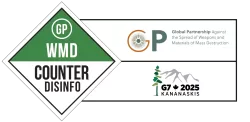A disinformation primer
INFORMATION WARFARE
Disinformation is a set of carefully constructed false messages leaked to an opponent‘s communication system in order to deceive the decision-making elite or the public. The purpose is to weaken adversaries from the inside and undermine collective responses to challenges. As a campaign, it is best understood as a type of information warfare. The techniques deployed in information warfare are known as ‘active measures.’
ACTIVE MEASURES:
- Sow confusion over facts and their sources
- Exacerbate divisive political fissures
- Erode trust in civil and scientific institutions
- Undermine citizen confidence in democratic governance

COVID-19: A MASTER CLASS EXAMPLE OF BIOWEAPONS DISINFORMATION MONITOR
The COVID-19 pandemic illustrates how disinformation can be used to undermine an adversary.
A 2020 report by the European Commission found that foreign actors and countries, led by Moscow and Beijing, had carried out targeted disinformation campaigns aimed at stoking confusion about the COVID-19 pandemic. These disinformation campaigns boosted conspiracy theories on the origin of the virus and appropriate mitigation efforts, and they smeared scientific institutions and policymakers.
A 2020 US State Department report noted that Kremlin-linked sites were boosting false and debunked allegations that SARS-CoV-2 was created in a lab as a bioweapon, that billionaire Bill Gates was plotting to use the pandemic as an excuse to microchip people, and that plans for the vaccine were a well-orchestrated money grab by pharmaceutical companies.
The success of these disinformation campaigns was demonstrated in the actions of citizens and policymakers to mitigate the spread and impact of the pandemic in their own communities. As far away as Australia, protestors held up ‘Arrest Bill Gates’ signs; while in the UK, angry citizens attacked 5G towers and the engineers sent to repair them. Later, health officials, nurses and pharmacists were targeted with death threats, leading to problems of retention and replacement.
KEY MESSAGES
- There are profound geostrategic motivations of disinformation campaigns, and the vectors used to reach domestic audiences have never been more accessible. Social media, amplified through bots and trolls, has allowed disinformation campaigns to spread through global audiences cheaply, remotely and in real time.
- In the credibility confusion created through disinformation, a mix of extremists, charlatans and profit seekers is typically boosted over credible sources of information. Security agencies have noted how extremist groups have leveraged disinformation to build their popularity for recruitment and legitimization, even mounting successful electoral campaigns. These newly elected office holders have come to directly influence policymaking and undermine the funding of public goods such as health and education.
- Disinformation is most influential when spread through traditional media or endorsed by groups and individuals with high community respect. Depending on the country, this could be political or religious leaders, judges, military members, or other trusted members of the target community. Research demonstrates that cyber-enabled disinformation has been microtargeted to influence these key groups. To build societal resilience against disinformation, training must reach these target groups.
- By undermining trust and investment in institutions and creating confusion over facts, disinformation stymes collective action and cooperation both domestically and with international partners. Disinformation fractures alliances by undermining a sense of shared reality and the will to fight together against common challenges. The international community must work together to combat disinformation as a threat to all nations.
